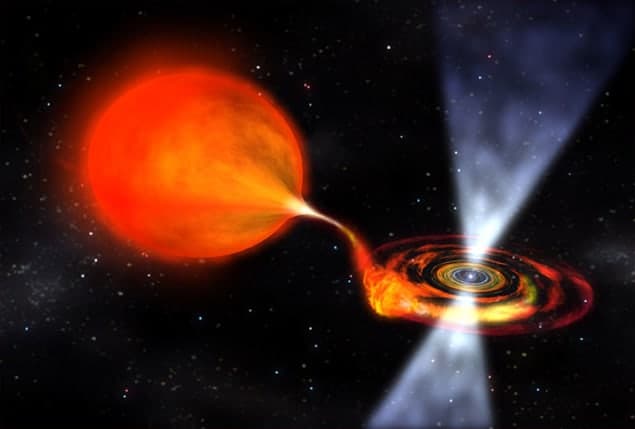
An interstellar navigation technique that taps into the highly periodic signals from X-ray pulsars is being developed by a team of scientists from the National Physical Laboratory (NPL) and the University of Leicester. Using a small X-ray telescope on board a craft, it should be possible to determine its position in deep space to an accuracy of 2 km, according to the researchers.
Referred to as XNAV, the system would use careful timing of pulsars – which are highly magnetized spinning neutron stars – to triangulate a spacecraft’s position relative to a standardized location, such as the centre-of-mass in the solar system, which lies within the Sun’s corona. As pulsars spin, they emit beams of electromagnetic radiation, including strong radio emission, from their magnetic poles. If these beams point towards Earth, they appear to “pulse” with each rapid rotation.
Some pulsars in binary systems also accrete gas from their companion star, which can gather over the pulsar’s poles and grow hot enough to emit X-rays. It is these X-ray pulsars that can be used for stellar navigation – radio antennas are big and bulky, whereas X-ray detectors are smaller, often armed with just a single-pixel sensor, and are easier to include within a spacecraft’s payload.
X-ray payload
By 2013, theoretical work describing XNAV techniques had developed to the point where the European Space Agency commissioned a team, led by Setnam Shemar at NPL, to conduct a feasibility study, with an eye to one day using it on their spacecraft.
Shemar’s team analysed two techniques. The simplest is called “delta correction”, and works by timing incoming X-ray pulses – from a single pulsar – using an on-board atomic clock and comparing them to their expected time-of-arrival at the standardized location. The offset between these two timings, taken together with an initial estimated spacecraft position from ground tracking, can be used to obtain a more precise spacecraft position. This method is designed to be used in conjunction with ground-based tracking by NASA’s Deep Space Network or the European Space Tracking Network to provide more positional accuracy. Simulations indicated an accuracy of 2 km when locked onto a pulsar for 10 hours, or 5 km with just one hour of observation.
The benefits of this method would be most apparent in missions to the outer solar system, says Shemar, where the distance means that ground tracking is less accurate than within the inner solar system, where the XNAV system could be calibrated. However, Werner Becker of the Max Planck Institute for Extraterrestrial Physics, who was not involved in the current work, points out that such a system would not be automated and would still rely on communication with Earth.
Shemar agrees, which is why his team also considered a second technique, known as “absolute navigation”. To determine a location in 3D space, one must have the x, y and z co-ordinates, plus a time co-ordinate. If a spacecraft has an atomic clock on board, then this could be achieved by monitoring a minimum of three pulsars – if there is no atomic clock, a fourth pulsar would be required. The team’s simulations indicate that at the distance of Neptune, a spacecraft could autonomously measure its position to within 30 km in 3D space using the four-pulsar system.
Limits to technology
The downside to absolute navigation is that either more X-ray detectors are required – one for each pulsar – or a mechanism to allow the X-ray detector to slew to each pulsar in turn would need to be implemented. It’s a trade-off, points out Shemar, between accuracy and the practical limits of technology and cost. Becker, for instance, advocates using up to 10 pulsars to provide the highest accuracy, but implementing this on a spacecraft may be more difficult.
While the engineering behind such a steering mechanism is complex, “it’s not miles out of the scope of existing technology,” says Adrian Martindale of the University of Leicester, who participated in the feasibility study. In terms of the cost, complexity and size of X-ray detector required for XNAV, the team cites the example of the Mercury Imaging and X-ray Spectrometer (MIXS) instrument that will launch to the innermost planet on the upcoming Bepi-Colombo mission in 2018.
“We’ve shown that we think it is feasible to achieve,” Shemar told physicsworld.com, adding the caveat that some of the technology needs to catch up with the theoretical work. “Reducing the mass of the detector as far as possible, reducing the observation time for each pulsar and having a suitable steering mechanism are all significant challenges to be overcome.”
In February 2017, NASA plans to launch the Neutron star Interior Composition Explorer (NICER), to the International Space Station. Although primarily for X-ray astronomy, NICER will also perform a demonstration of XNAV. As this idea of pulsar-based navigation continues to grow, “space agencies may begin to take a more proactive role and start developing strategies for how an XNAV system could be implemented on a space mission,” says Shemar.
Becker is a little more sceptical about how soon XNAV will be ushered in for use on spacecraft. “The technology will become available when there is a need for it,” he says. “Autonomous pulsar navigation becomes attractive for deep-space missions but there are none planned for many years.”
The research is published in the journal Experimental Astronomy.



